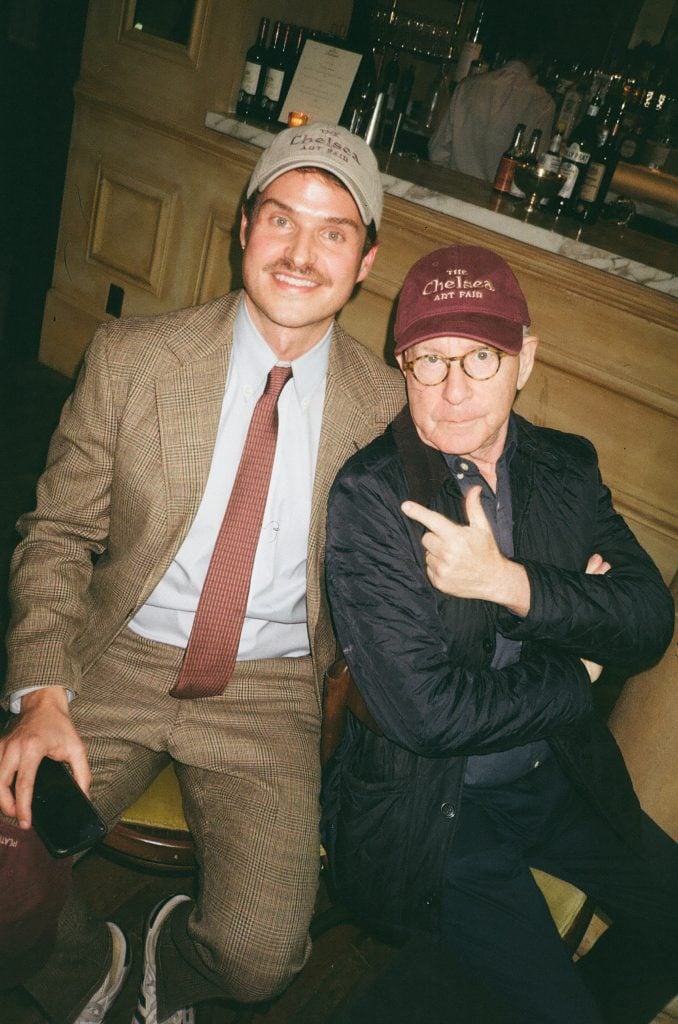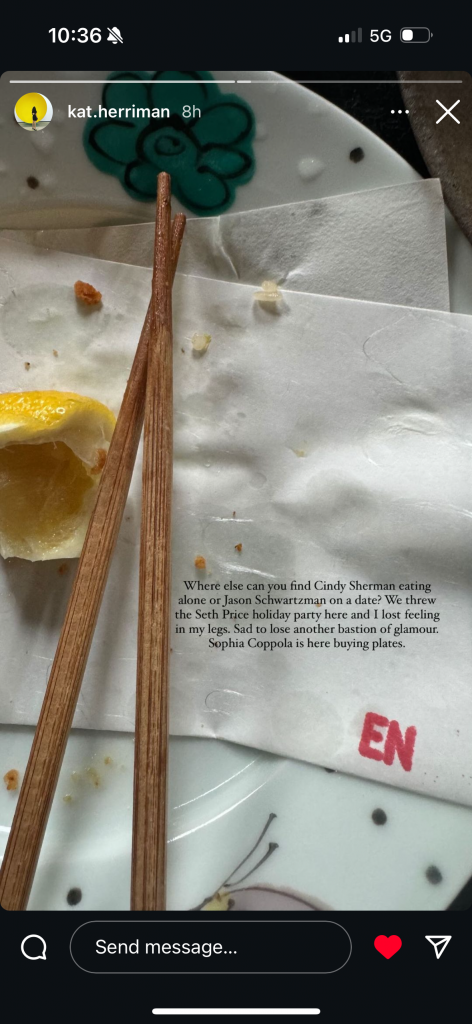Wet Paint
A Tiny Art Fair Takes Over the Chelsea Hotel—and More Juicy Art Gossip
Plus, from which shuttered art world haunt has Sofia Coppola been buying dishware? And who just joined Gladstone's roster from another Chelsea enterprise?

Plus, from which shuttered art world haunt has Sofia Coppola been buying dishware? And who just joined Gladstone's roster from another Chelsea enterprise?

Annie Armstrong

Every week, Artnet News brings you Wet Paint, a gossip column of original scoops. If you have a tip, email Annie Armstrong at [email protected].
Who can resist drooling over the history of the Chelsea Hotel? It has hosted and inspired some of the greatest minds in American culture. The rest of my life could be spent reveling in just the poetry that came from that building on West 23rd Street. It’s where Leonard Cohen “remembered” Janis Joplin so “well” in 1972. It’s where Raymond Foye and artist Francesco Clemente published their cultish Hanuman Books from 1986 to 1993. It’s where Edgar Lee Masters called for “Anita!” in 2005, when the hotel was crumbling. And of course, a few years after its 2021 renovation, it’s where dealer Matthew Brown boldly declared, “The art market is booming. Put that on the record!”
Maybe the last one won’t make it into the history books, but after the year we’ve had, it sounded a little like poetry when I heard him say it there early on Saturday afternoon. Outside, a massive crowd was lined up around the block to see the Chelsea Art Fair, a tiny, day-long art fair hosted by David Zwirner’s e-commerce website, Platform. Only five galleries—a veritable cool-kid’s club—were exhibiting: Lomex, 56 Henry, Castle, Ramiken, and Matthew Brown. In an event space on the ground floor of the hotel, straddled between two bars and tucked behind a private dining room, drywall was erected to give way to a jewel box of an art fair.
“We were having a Platform team dinner at the Café Chelsea in May, and one of the team members said, in jest, that we should do an art fair here,” Richard Thayer, the COO of Platform, told me. The idea seemed like a good one, and the team already had an existing relationship with Sean MacPherson, the co-owner of the hotel, who had bought a few pieces from Platform. “We had talked to them about doing some projects to reinvigorate the hotel’s history with art,” Thayer said, “So I asked him, and he was into it!”

Richard Thayer, left, with Jerry Saltz, right. Photo by Matthew Weinberger.
They decided to keep the list of exhibitors short, mostly for the sake of convenience. 56 Henry’s founder, Ellie Rines, said it was fun to show with a group of galleries where there are no “weak links. Unless we’re the weak link. And we might be!” It didn’t seem that way, though. The Downtown dealer had already sold a sculpture by Ohad Meromi for $14,000 and had a soft sculpture by Al Freeman Jr. on hold for $15,000 after selling one of Freeman’s drawings to Platform founder Lucas Zwirner for $2,500.
“It’s nice to get to show over here in Chelsea,” Rines said. “A lot of these people don’t make it all the way over to Chinatown.”
Another gallerist taking full advantage of the fair’s location was Harley Wertheimer, who runs the small-but-mighty Los Angeles space Castle. It was the first time that the gallery—now in its third year and founded in Wertheimer’s home—had done an art fair. “The idea of doing something with a bigger scope that is also very intimate is really exciting for me,” he said. “I think people find it refreshing to see art in this context, and the energy has been really special for my first fair.” The paintings he brought over from the West Coast, a group of small-scale geometric portraits by James Iveson priced between $5,000 and $7,000, had sold out just a few hours into the fair’s opening.
Speaking of Los Angeles galleries: an exuberant-looking Alex Shulan, Lomex’s proprietor, had just sold a $22,000 painting by Joseph Geagan, the founder of Gaylord Apartments in L.A.’s Koreatown. “Yeah, I’ve sold quite a bit of art,” he told me. The night before, his booth attracted quite the audience at a cocktail-party preview, where a drink called the “Rrose Sélavy” had the scene in high spirits. The festivities ending up going late night in some of the hotel’s rooms provided to the gallerists.
According to Thayer, the team had originally planned to stage the fair in hotel rooms, á la Felix Art Fair and the Gramercy International Art Fair (which became the Armory Show). “I think people like the condensed nature of it,” he said. There are no booth fees for the gallerists, but instead Platform takes 20 percent from all sales at the fair, as is standard for all sales that happen on the website.
“We’re not trying to start an art fair on the scale of, like, a NADA, by any means,” Thayer replied, when I asked if he’d be interested in expanding. “But yeah, we’d be interested in more opportunities to do Platform projects offline.” The art fair “feels like a pretty good representation of” a possible model, he went on. “It’s a dream come true.”

Beloved gallery-dinner spot EN Brasserie has closed its doors, and I don’t know if I can come up with a better tribute than the one delivered by Nina Johnson’s director, Kat Herriman… Speaking of passings, I’d like to hold some space for the passing of Bert, the Instagram-famous dog who belonged to Kathy Grayson, owner of the Hole. His subdued energy at art fairs was enviable, and he always looked dynamic posing in front of a painting. Rest in peace!… Miami is molting: I hear that White Cube‘s Monday night slot at Soho Beach House in Miami Beach has been taken over by a New York clubstraunt… Painter Karen Kilimnik has parted ways with 303 Gallery for representation with Gladstone in collaboration with Sprüth Magers… Collector Larry Warsh embraced social media to bring the masses to see his Keith Haring at Sotheby’s… And finally, a parting shot from Los Angeles-based artist Jake Longstreth…
Hauser & Wirth and Walmart ads back to back on How Long Gone— those boys are cooking up a strange brew
— Jake Longstreth (@dongstreth) November 18, 2024
For this week’s grievance, here’s one that hits close to home as a journalist on the art beat. I’ll admit in earnest that I didn’t know of such a practice, and I’d encourage any writer who has partaken in it to take a hard look in the mirror and perhaps consider a new field…
My grievance is with the crop of new, young writers who are asking (even demanding) PR companies, artists, and galleries to pay their “writer fees,” essentially charging them for work that their publications already pay for. I spent years busting my ass as a freelancer to get higher-paying writing gigs. Yes, publications need to pay more, but taking payment from the person you’re writing about exacerbates the issues of the media landscape. One publicist with an art publication (conflict much?) recently wrote about why she thinks PR companies should budget to pay writers, publishing this op-ed on a blog that ironically doesn’t pay their writers. These messy, ethically questionable situations are what make it so hard to earn a living as a writer and to trust what’s being published.
What has been bothering you? Send your contribution to me at [email protected] with the subject line “GRIEVANCES.”